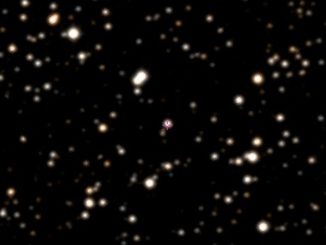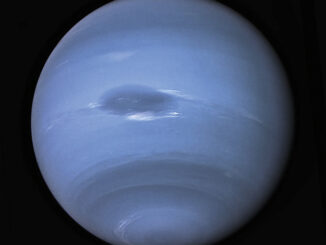
There’s strong new evidence that an undiscovered large planet exists on the fringes of our Solar System, according to two Caltech scientists who have looked at the odd behaviour of numerous distant Kuiper Belt Objects.
Nicknamed ‘Planet Nine’, this world would have a mass around ten times greater than Earth and its highly elongated orbit would be 20 times further from the Sun on average than Neptune, taking up to 20,000 years to make one complete trip around the Sun.
To be clear, nobody has observed and discovered this planet yet, but Caltech’s Mike Brown and Konstantin Batygin are convinced it exists, presenting their claim in the 20 January 2016 issue of The Astronomical Journal. Ironically, Brown was the man ultimately responsible for the reclassification of Pluto as a dwarf planet, following his discovery of another dwarf planet, Eris.
“OK, OK, I am now willing to admit: I DO believe that the Solar System has nine planets” Brown (@plutokiller) joked on Twitter.
“This would be a real ninth planet,” he says. “There have only been two true planets discovered since ancient times and this would be a third. It’s a pretty substantial chunk of our Solar System that’s still out there to be found, which is pretty exciting.”
Brown and Batygin became suspicious in 2014, following the discovery of a distant Kuiper Belt Object, named 2012 VP113, by Chad Trujillo and Scott Shepherd of Gemini Observatory and the Carnegie Institution respectively. VP113 has one of the most elongated orbits known, with its closest point to the Sun – known as perihelion – the most distant of any object in the Solar System discovered so far, at 80 times further from the Sun than Earth. VP113’s most distant point is as far out as 446 times further from the Sun than Earth. Indeed, VP113 and several other Kuiper Belt Objects, including an object called Sedna that was discovered in 2003, exist beyond a region known as the ‘Kuiper Cliff’, where the number of objects seems to fall off rapidly for no clear reason.
Trujillo and Shepherd wondered if a planet hidden somewhere deep in the Kuiper Belt could explain the strangely elongated orbits of objects such as VP113 and Sedna. Brown and Batygin took it upon themselves to follow up and see whether there was any credence to this suggestion. Analysing the orbits of already-known Kuiper Belt Objects, they found eerie similarities between six of them. Typically the orbits of objects in the Kuiper Belt are not level with the plane of the Solar System, but are inclined and more greatly elongated than those of the planets, meaning that they feature a range of directions. However, Brown and Batygin discovered that these six all had orbits that pointed in the same direction, and their orbits were all were tilted down towards the plane of the Solar System by 30 degrees. Such uniformity in the Kuiper Belt is deemed highly suspicious.
“It’s almost like having six hands on a clock all moving at different rates and when you happen to look up, they’re all in exactly the same place,” says Brown. “It shouldn’t happen randomly, so we thought something else must be shaping these orbits.”
By running computer simulations and mathematical models, Brown and Batygin found the explanation. There must be another planet present in the Solar System, travelling around the Sun in an ‘anti-aligned’ orbit whereby its perihelion is on the other side of the Solar System to all the other planets. Its mass would pull bodies like VP113 and Sedna away from Neptune’s gravitational grasp and towards it, trapping them in resonant orbits like the six observed, while clearing out the zone of the Kuiper Cliff, in the same manner that Jupiter’s gravity clears out the Kirkwood Gaps in the Asteroid Belt.
It is a nice theory, but theories must be verified by being able to make predictions that can then be tested. The simulations predicted that the unseen Planet Nine would push some Kuiper Belt objects up into orbits that are perpendicular – at 90 degrees – to the plane of the Solar System, so that they loop high over the Sun’s poles. Then Batygin realised that four Kuiper Belt objects had already been discovered on exactly this kind of orbit.
“We plotted the positions of those [four] objects and their orbits and they matched the simulations exactly,” says Brown. “When we found that, my jaw sort of hit the floor.”
Still, simulations cannot confirm the planet’s existence – only observing it can do that and so the hunt for Planet Nine now begins. If the planet is close to perihelion, it would be bright enough to perhaps have already been captured by astronomical surveys without anybody realising. On the other hand if Planet Nine is near its furthest point in its orbit, only the biggest telescopes in the world, such as the Keck ten-metre telescopes, would have a chance of spotting it. The trouble is its orbit is only approximately known and there is a lot of sky to cover.
The presence of Planet Nine could also solve other riddles in our Solar System. Exoplanet surveys show that the most common type of world are ‘super-earths’ and ‘mini-neptunes’, which have masses range between Earth’s mass and Neptune’s mass. Our Solar System, however, seems to be mysteriously missing this kind of common world. Meanwhile, simulations of the formation of the planets and the way they migrated in the early Solar System also suggest that there once could have been another large world in the outer Solar System that got kicked out through gravitational interactions with the other giant planets. Could Planet Nine be this long lost world, sent into purgatory at the very edge of the Solar System?
This awaits to be seen, and it’s telling that while astronomers have found around 2,000 planets around other stars, it seems that not all the planets around the Sun have yet been accounted for. It also provides a way for Brown to assuage those who are angry with him about Pluto’s reclassification.
“All those people who are mad that Pluto is no longer a planet can be thrilled to know that there is a real planet out there still to be found,” says Brown. “Now we can go and find this planet and make the Solar System have nine planets once again.”



